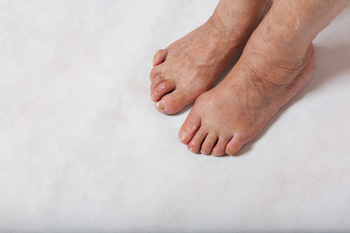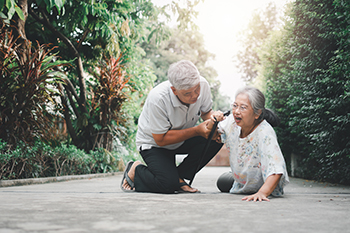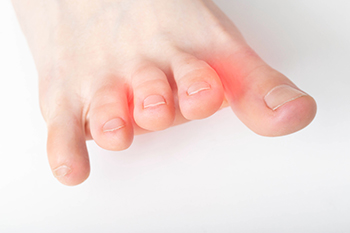Baytown, TX (281) 837-8371
December 2022
Two Types of Hammertoe

Hammertoe is considered to be a foot deformity. It is a fairly common ailment and can be caused by genetic reasons, or by wearing shoes that are too tight. When these types of shoes are frequently worn, the toes can squeeze together, causing the middle joint in the second and third toes to bend down, resembling a hammer. Hammertoe can fall into two categories which are known as flexible or rigid. It is easier to treat flexible hammertoe because the joints are much more pliable, and they can be bent back to their natural place. Conversely, rigid hammertoe is considered to be severe, and surgery may be the only option for permanent straightening. Some of the symptoms that accompany hammertoe can include foot pain, corns that form on top of the toes, and the range of motion may be limited. If you have signs of developing hammertoe, please schedule an appointment with a podiatrist as quickly as possible who can help you with the treatment option that is correct for you.
Hammertoes can be a painful condition to live with. For more information, contact Abeer M. Foteh, DPM of Greater Houston Foot Centers. Our doctor will answer any of your foot- and ankle-related questions.
Hammertoe
Hammertoe is a foot deformity that occurs due to an imbalance in the muscles, tendons, or ligaments that normally hold the toe straight. It can be caused by the type of shoes you wear, your foot structure, trauma, and certain disease processes.
Symptoms
- Painful and/or difficult toe movement
- Swelling
- Joint stiffness
- Calluses/Corns
- Physical deformity
Risk Factors
- Age – The risk of hammertoe increases with age
- Sex – Women are more likely to have hammertoe compared to men
- Toe Length – You are more likely to develop hammertoe if your second toe is longer than your big toe
- Certain Diseases – Arthritis and diabetes may make you more likely to develop hammertoe
Treatment
If you have hammertoe, you should change into a more comfortable shoe that provides enough room for your toes. Exercises such as picking up marbles may strengthen and stretch your toe muscles. Nevertheless, it is important to seek assistance from a podiatrist in order to determine the severity of your hammertoe and see which treatment option will work best for you.
If you have any questions, please feel free to contact our office located in Baytown, TX . We offer the newest diagnostic and treatment technologies for all your foot care needs.
Take Action to Prevent Falls in Seniors

As we age, the idea of independent living becomes a reality that must be faced. One of the chief factors in remaining independent as a senior is preventing falls. Risks of falls are directly related to muscle strength, fatigue, loss of balance, and numbness in the feet. Balance problems include dizziness when standing up suddenly, vertigo when the head turns, and feeling unsteady when walking. Actions that can be taken by seniors to help prevent falls include, using a walking aid if you are unsure about your balance. This action can give you the confidence to be more active, as becoming sedentary contributes to the loss of muscle strength. Checking prescriptions of any medication you take for side effects, such as dizziness, is a good idea. Experts also recommend having your eyesight checked to see if you may need new glasses. Balance exercises and light exercise are suggested, as long as you stop to rest when you get tired. Supportive and properly fitting footwear with ample cushioning and non-skid soles are also a good idea. For more ways to prevent falling, please consult a podiatrist.
Preventing falls among the elderly is very important. If you are older and have fallen or fear that you are prone to falling, consult with Abeer M. Foteh, DPM from Greater Houston Foot Centers. Our doctor will assess your condition and provide you with quality advice and care.
Every 11 seconds, an elderly American is being treated in an emergency room for a fall related injury. Falls are the leading cause of head and hip injuries for those 65 and older. Due to decreases in strength, balance, senses, and lack of awareness, elderly persons are very susceptible to falling. Thankfully, there are a number of things older persons can do to prevent falls.
How to Prevent Falls
Some effective methods that older persons can do to prevent falls include:
- Enrolling in strength and balance exercise program to increase balance and strength
- Periodically having your sight and hearing checked
- Discuss any medications you have with a doctor to see if it increases the risk of falling
- Clearing the house of falling hazards and installing devices like grab bars and railings
- Utilizing a walker or cane
- Wearing shoes that provide good support and cushioning
- Talking to family members about falling and increasing awareness
Falling can be a traumatic and embarrassing experience for elderly persons; this can make them less willing to leave the house, and less willing to talk to someone about their fears of falling. Doing such things, however, will increase the likelihood of tripping or losing one’s balance. Knowing the causes of falling and how to prevent them is the best way to mitigate the risk of serious injury.
If you have any questions, please feel free to contact our office located in Baytown, TX . We offer the newest diagnostic and treatment technologies for all your foot care needs.
Benefits of Scheduling Easy Running Days

Runners who do not care for their feet or practice good foot care habits can be setting themselves up for a nasty foot injury. If you are a runner, ensure that you are doing everything you can to protect your foot from injury. One important precautionary step you can take is to run easy, or non-strenuously, during scheduled easy running days. For example, when a runner exerts themselves on such days, it can tire the feet and make running at a high pace more difficult during harder runs. Taking easy days too seriously can also add extra stress to the feet, making them more susceptible to injury. If you are a runner, ensure that you are doing what you can to protect them from injuries. Working with a podiatrist can greatly help in this respect. Schedule an appointment today.
Exercising your feet regularly with the proper foot wear is a great way to prevent injuries. If you have any concerns about your feet, contact Abeer M. Foteh, DPM of Greater Houston Foot Centers. Our doctor will treat your foot and ankle needs.
How to Prevent Running Injuries
Many common running injuries are caused by overuse and overtraining. When the back of the kneecap starts wearing out and starts causing pain in your knee, this is commonly referred to as runner’s knee. Runner’s knee is a decrease in strength in your quadriceps and can occur if you’re not wearing properly fitted or supporting shoes. To prevent runner’s knee, focusing on hip strengthening is a good idea, as well as strengthening your quads to keep the kneecaps aligned.
What Are Some Causes of Running Injuries?
- One cause of a common running injury is called iliotibial band syndrome.
- Plantar fasciitis is also another common injury.
- Stress fractures can occur from overtraining, lack of calcium, or even your running style.
Best Ways to Prevent Running Injuries
- Wear footwear that fits properly and suits your running needs.
- Running shoes are the only protective gear that runners have to safeguard them from injury.
- Make a training schedule. Adding strengthening exercises as well as regular stretching can help keep you strong and limber and can lessen the possibility of injuries.
- Stretching keeps muscles limber; this will help you gain better flexibility.
If you have any questions please feel free to contact our office located in Baytown, TX . We offer the newest diagnostic and treatment technologies for all your foot and ankle needs.
Wounds That Don't Heal Need to Be Checked
What Can Cause Morton’s Neuroma?

The foot condition that is known as Morton’s neuroma can cause debilitating pain and discomfort. This is an ailment that affects the nerve which lies between the third and fourth toes, causing it to become thickened and irritated. It is a condition that can be common among women who frequently wear high heels. These types of shoes generally have little area in the toe box, prohibiting the toes to move freely. Patients who have Morton’s neuroma often liken the pain in their feet to having a pebble or marble in their shoe. Additionally, there may be a burning sensation in the ball of the foot, as a result of extreme inflammation. There may be existing conditions affecting the feet which can lead to getting this condition, including bunions, flat feet, or high arches. A proper diagnosis consists of pressing on specific areas of the affected foot, and an X-ray may be taken to rule out fractures or arthritis. The discomfort from this ailment is difficult to ignore, and if you are afflicted with this type of pain, please schedule an appointment with a podiatrist as quickly as possible who can help you to find relief.
Morton’s neuroma is a very uncomfortable condition to live with. If you think you have Morton’s neuroma, contact Abeer M. Foteh, DPM of Greater Houston Foot Centers. Our doctor will attend to all of your foot care needs and answer any of your related questions.
Morton’s Neuroma
Morton's neuroma is a painful foot condition that commonly affects the areas between the second and third or third and fourth toe, although other areas of the foot are also susceptible. Morton’s neuroma is caused by an inflamed nerve in the foot that is being squeezed and aggravated by surrounding bones.
What Increases the Chances of Having Morton’s Neuroma?
- Ill-fitting high heels or shoes that add pressure to the toe or foot
- Jogging, running or any sport that involves constant impact to the foot
- Flat feet, bunions, and any other foot deformities
Morton’s neuroma is a very treatable condition. Orthotics and shoe inserts can often be used to alleviate the pain on the forefront of the feet. In more severe cases, corticosteroids can also be prescribed. In order to figure out the best treatment for your neuroma, it’s recommended to seek the care of a podiatrist who can diagnose your condition and provide different treatment options.
If you have any questions, please feel free to contact our office located in Baytown, TX . We offer the newest diagnostic and treatment technologies for all your foot care needs.








